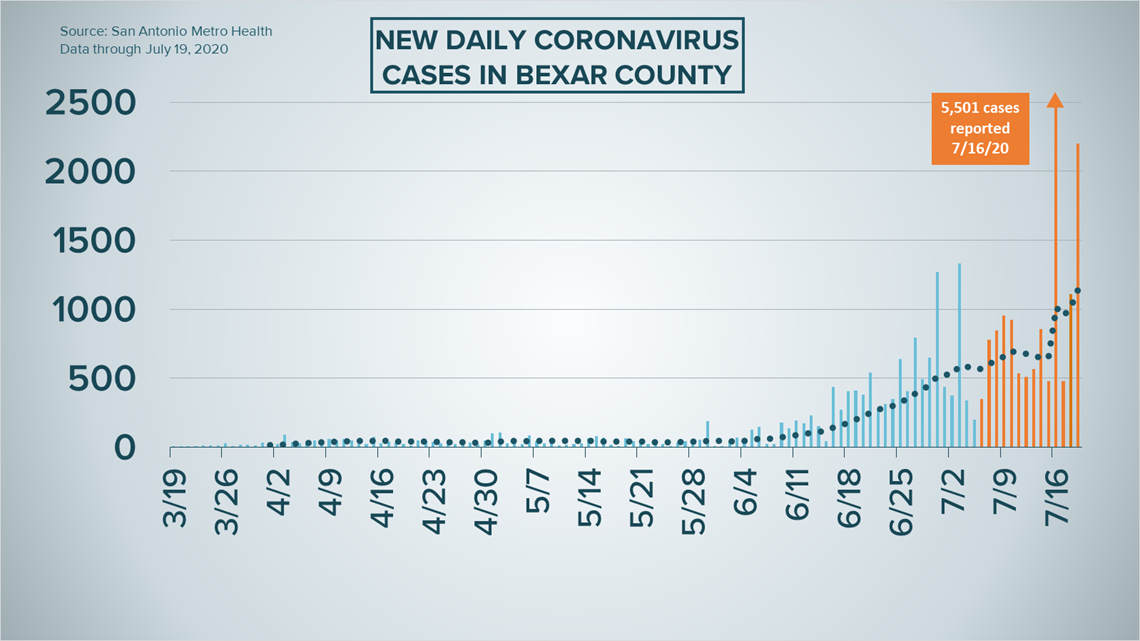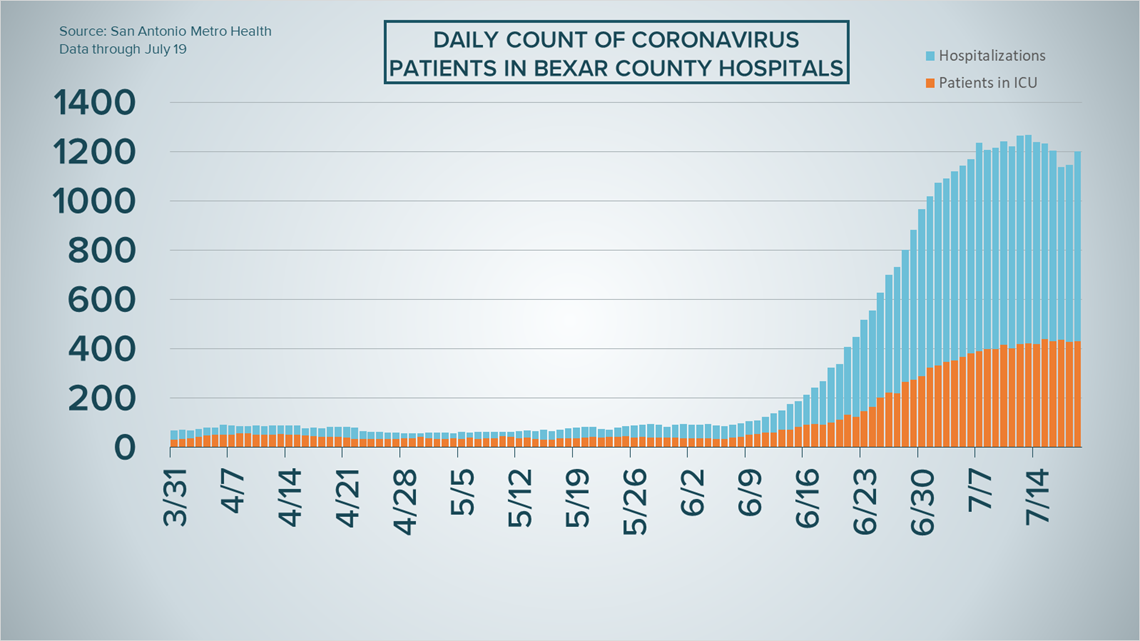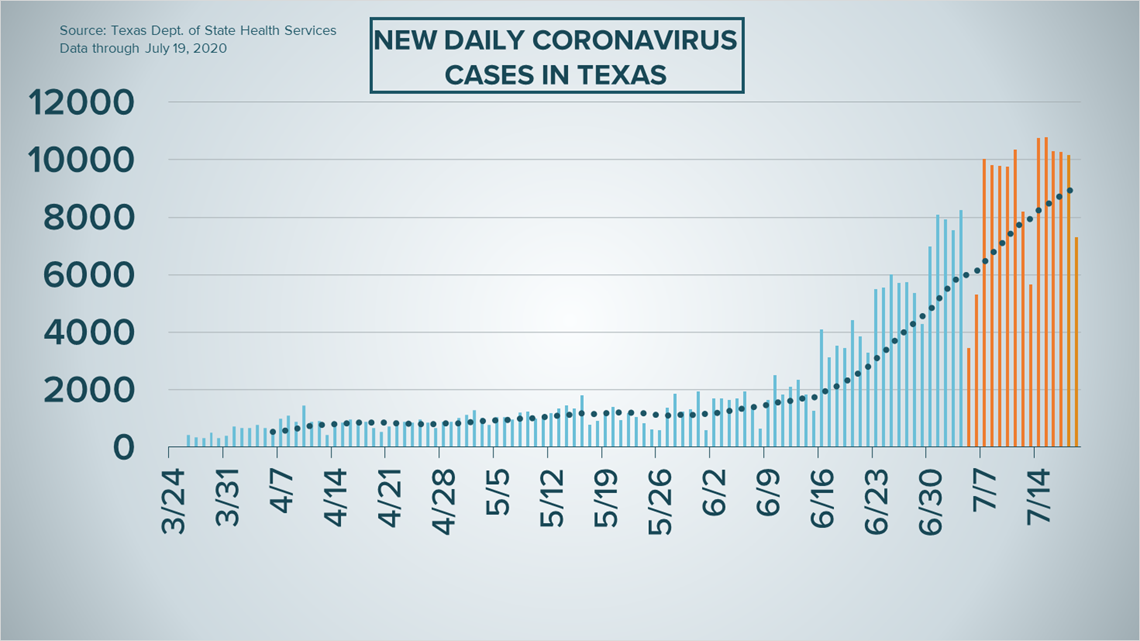SAN ANTONIO — We're tracking the latest numbers from the coronavirus pandemic in San Antonio and across Texas. Here are the latest numbers reported by Bexar and surrounding counties:
- Bexar County: 2,202 new cases and six fatalities from COVID-19 were reported Sunday. There have been a total of 30,835 cases and 257 virus-related fatalities in the county.
- Comal County: 109 new cases were reported Saturday, along with two additional virus-related deaths. There have been a total of 1,667 cases and 37 virus-related fatalities in the county.
- Hays County: 49 new cases were reported Thursday, along with three additional virus-related deaths. There have been a total of 3,865 cases and 17 virus-related fatalities in the county
How Bexar County is trending:
We're tracking how many coronavirus cases are confirmed in Bexar County each day from the time San Antonio Metro Health began reporting cases more than two months ago. Graphing those daily case numbers along a 14-day moving average provides an accurate picture of the curve in the San Antonio area and the direction we're heading amid the coronavirus.
On Sunday, Metro Health reported 2,202 additional coronavirus cases, bringing the total in Bexar County to 30,835. Six additional virus-related deaths were also reported; in all, 257 Bexar County residents have died from complications with the coronavirus.


This is by far the biggest single-day increase. Not counting Thursday's figures, which included what leaders called a "backlog" of tests dating back about two weeks, this is just the fourth time that Metro Health has reported more than 1,000 cases during the ongoing pandemic.
Mayor Nirenberg urged San Antonians to take coronavirus seriously in a tweet shortly before numbers were released Sunday.
The number of Bexar County residents hospitalized with COVID-19 jumped to 1,199. There are 431 patients currently in the ICU, and a record-high 299 currently on ventilators.


San Antonio Metro Health reports the full daily numbers at 7 p.m.
Coronavirus in Texas
State health officials reported 7,300 newly-confirmed coronavirus cases on Sunday, following five consecutive days of at least 10,000 positive COVID-19 tests in Texas. That raises the total number of COVID-19 cases in the ongoing pandemic to 325,030, with 65,826 coming in the last week.


The state also reported an additional 93 virus-related deaths, making it 766 fatalities in the last week. In all, 3,958 have tragically lost their lives to the virus.


The number of patients in Texas hospitals dropped slightly to 10,592 on Sunday. On Saturday, a record-high 10,658 Texans were being treated in facilities for the virus.
Latest Coronavirus Headlines
- Governor Abbott announces U.S. Navy support in Rio Grande Valley, Southwest Texas to help combat COVID-19
- Houston pastor died within days of COVID-19 diagnosis, family says
- Kentucky couple on house arrest for refusing to sign self-isolation order after one tests positive for coronavirus
- 'We need football' | Drew Brees criticizes NFL's coronavirus plan
- NFL tells teams training camps will open on time
- 'It's an honor to be in San Antonio' | US Army continues military COVID-19 operations in Texas
- 'Every room is occupied': Del Rio mayor calling for voluntary stay-at-home effort as county hospital nears capacity
- 2 San Antonio employees die from COVID-19 complications
- Bexar County schools cannot return to on-campus learning until after Sept. 7, health authority rules
- 'I wasn't happy when I found out': City leaders say state exemptions allowed multiple large events to unfold in SA as COVID-19 surged
Coronavirus symptoms
The symptoms of coronavirus can be similar to the flu or a bad cold. Symptoms include fever or chills, cough, shortness of breath or difficulty breathing, fatigue, muscle or body aches, headache, new loss of taste or smell sore throat, congestion or runny nose, nausea or vomiting and diarrhea, according to the Centers for Disease Control.
Most healthy people will have mild symptoms. A study of more than 72,000 patients by the Centers for Disease Control in China showed 80 percent of the cases there were mild.
But infections can cause pneumonia, severe acute respiratory syndrome, kidney failure, and even death, according to the World Health Organization. Older people with underlying health conditions are most at risk.
On June 25, the CDC expanded the list of groups at a higher risk of severe illness due to coronavirus.
Experts determined there was consistent evidence these conditions increase a person's risk, regardless of age:
- Chronic kidney disease
- COPD (chronic obstructive pulmonary disease)
- Obesity (BMI of 30 or higher)
- Immunocompromised state (weakened immune system) from solid organ transplant
- Serious heart conditions, such as heart failure, coronary artery disease, or cardiomyopathies
- Sickle cell disease
- Type 2 diabetes
The CDC believes symptoms may appear anywhere from two to 14 days after being exposed.
Human coronaviruses are usually spread...
- Between people who are in close contact with one another (within about 6 feet).
- Through respiratory droplets produced when an infected person coughs, sneezes or talks. These droplets can land in the mouths or noses of people who are nearby or possibly be inhaled into the lungs.
- Some recent studies have suggested that COVID-19 may be spread by people who are not showing symptoms.
Help stop the spread of coronavirus
- Stay home when you are sick.
- Eat and sleep separately from your family members
- Use different utensils and dishes
- Cover your cough or sneeze with your arm, not your hand.
- If you use a tissue, throw it in the trash.
Lower your risk
- Wash your hands often with soap and water for at least 20 seconds. If soap and water are not available, use an alcohol-based hand sanitizer.
- Avoid touching your eyes, nose, and mouth with unwashed hands.
- Avoid close contact with people who are sick.
- Clean and disinfect frequently touched objects and surfaces.
- The CDC recommends wearing a mask or cloth face covering if you have to be out due to an essential service or essential activity such as going to the grocery store.
- If you are 60 or over and have an underlying health condition such as cardiovascular disease, diabetes or respiratory illnesses like asthma or COPD, the World Health Organization advises you to try to avoid crowds or places where you might interact with people who are sick.

